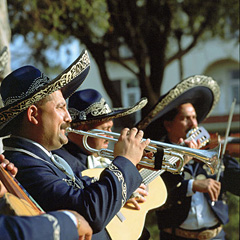
|  |  |  News from Around Banderas Bay | August 2008 News from Around Banderas Bay | August 2008  
Mariachi: The Heart and Soul of Mexico
 Jim Scherrer - PVNN Jim Scherrer - PVNN


| | To experience that unmistakable feeling of being in Mexico, be sure to take in some Mariachi music on your Puerto Vallarta vacation. | | |
Mariachi music, quite obviously the heart and soul of Mexico to anyone that has traveled south of the border, frequently permeates the Puerto Vallarta evening air. Mariachis can be heard serenading women at weddings, special occasions such as Quinceañeras (girls’ fifteenth birthday celebrations) and baptisms, Mother’s Day fiestas, and at private parties. Mariachis are also often seen and heard in many of the restaurants and cantinas and can be found roving along the beachfront Malecón and throughout public parks.

The Mariachis that perform at parties and special occasions are generally paid by the hour, whereas those practicing their trade in public areas, restaurants, and cantinas usually request a given amount of pesos per song. Other Mariachis, acting as street musicians or buskers, simply play their beautiful music for the public enjoyment and appreciate the tips they receive.

We all recognize the unique sound of Mariachi music when we hear it, however few of us truly appreciate what differentiates Mariachi from other music. In order to be classified as Mariachi, the group must include a Guitarron (a small acoustic base) and a Yihuela (a high-pitched five string guitar) along with a Mexican guitar, three or more violins, and one or more trumpets.

Normally, at least one of the musicians will also sing. The appearance of the Mariachis is also quite unique in that they commonly wear silver studded charro outfits with bow ties and wide-brimmed sombreros.

What is not so obvious and well known is the derivation of the word Mariachi and the birthplace of Mariachi. Although there are differing opinions regarding the origin of the word Mariachi, many believe it was derived from the French word "mariage," meaning wedding or marriage.

There is no doubt that Mariachi originated in the small city of Cocula, Jalisco, which is located in a farming valley approximately 100 miles east of Puerto Vallarta. Cocula, known as "the cradle of Mariachi," has a population of less than 30,000 inhabitants with its roots from Franciscan monks who persuaded the indigenous inhabitants of the surrounding areas to relocate to the valley soon after the Spanish Conquest around 1530 AD. Their unique form of music was first documented around 1880 and has grown in popularity ever since.

In fact, Mariachi music became the symbol of the Mexican Revolution from 1910 to 1920 because it represented the national spirit of the indigenous Mexican blood. It really wasn’t until after 1930 that this distinctive form of music was even recognized outside the state of Jalisco. Of course, today the sights and sounds of Mariachi are worldwide and well known by almost everyone.

Next, because numerous Mariachi troupes were performing throughout the state of Jalisco and the music was ideal for dancing, their admirers started the Zapateado; the traditional Mariachi dance technique which originated in Spain.

It became so popular that one of its varieties, the Mexican Hat Dance from Guadalajara (the capital of Jalisco and the second largest city in Mexico,) soon became the national dance of Mexico. The female dancers with their beautiful costumes provide a memorable sight as they strike the floor with the heels of their shoes and flare their brightly colored dresses of intricate patterns and designs while dancing around a sombrero.

Now that we know that Mariachi, the symbol of the Mexican Revolution, originated in the state of Jalisco, and that the national dance of Mexico, the Mexican Hat Dance, is also from Jalisco, we ask how these facts influence life in Vallarta today.

Well, aside from the perfect winter climate from November through May and the incredible scenery of the Sierra Madres and the Pacific Ocean, a visitor to the region might not even realize he’s in Mexico with all the taxi cabs, "big box" stores, air-conditioned shopping malls, multi-level parking garages, stadiums, airport, bus and maritime terminals, golf courses, hospitals, universities, convention center, and other large and modern facilities that you would expect in a city of 350,000 residents.

Therefore, in order to obtain that unmistakable feeling of being in Mexico, while visiting Vallarta, one should take in some Mariachi music and a hat dance (not to be confused with a lap dance!) Only then will the sensation of being in Mexico be fully appreciated; only then will the true flavor of Mexico be savored. The sights and sounds associated with Mariachi are uniquely Mexican as they exemplify the centuries old cultural mix of Latin America and Europe.

In summarizing; picture this: you’re with your wife or girlfriend enjoying an evening dinner at one of Puerto Vallarta's fine beachfront restaurants with an ocean view and mountain backdrop. The temperature is perfect, there’s a gentle evening breeze, tropical flowers are on the table, and you’re sipping a frozen Margarita or cerveza while listening to Mariachis and watching the sunset in Paradise.

It just doesn’t get much more romantic than that! Mexicans are known to be very romantic by nature, and influenced by Mariachi, it’s no wonder that Puerto Vallarta is known as one of the most romantic resort destinations in the world. What better place to retire, than amongst the romantic sights and sounds of Mariachis?
 The founder of Puerto Vallarta Real Estate Buyers' Agents (PVREBA), Jim Scherrer is a retired entrepreneur who has owned property in Puerto Vallarta for 24 years. Utilizing his experience and extensive knowledge of the area, Jim has written a series of informative articles about travel to and retirement in Puerto Vallarta, which you can read on his website at PVREBA.com. The founder of Puerto Vallarta Real Estate Buyers' Agents (PVREBA), Jim Scherrer is a retired entrepreneur who has owned property in Puerto Vallarta for 24 years. Utilizing his experience and extensive knowledge of the area, Jim has written a series of informative articles about travel to and retirement in Puerto Vallarta, which you can read on his website at PVREBA.com.

Click HERE for more articles by Jim Scherrer. |

 |
|  |



